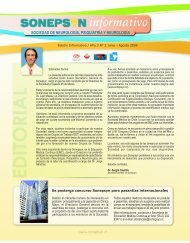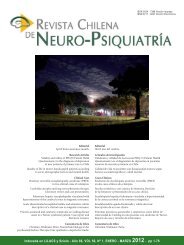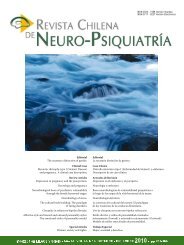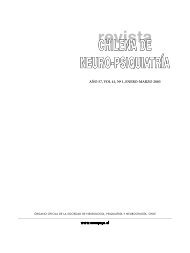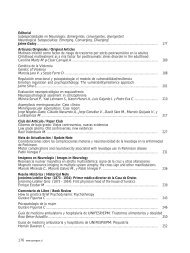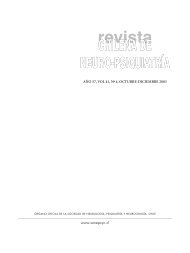Revista 3-2012 (PDF) - Sonepsyn
Revista 3-2012 (PDF) - Sonepsyn
Revista 3-2012 (PDF) - Sonepsyn
Create successful ePaper yourself
Turn your PDF publications into a flip-book with our unique Google optimized e-Paper software.
Casos Clínicos<br />
Afasia logopénica: presentación de un caso y revisión<br />
de la literatura<br />
Logopenic Aphasia: a case report an review of the literature<br />
Sandra Baeza V. 1 , Carla Bustos R. 1 y Pamela Ovando B. 1<br />
With the progressive aging of the Chilean population the diagnosis of neurodegenerative<br />
disorders is increasingly common, and among them is Primary Progressive Aphasia (PPA),<br />
with specific symptoms but late consultation. PPA is a clinical syndrome characterized by the<br />
degeneration of language regions in the dominant hemisphere that determines an insidious<br />
and progressive loss of language. Two types of PPA were recognized: Progressive non-fluent<br />
Aphasia (APnF) and Progressive Semantic Aphasia (DS), and was recently identified as a new<br />
type, Logopénica Progressive Aphasia (APL). We describe a case evaluated at the University of<br />
Chile Clinical Hospital of a woman of 54 years who have a history of 2-3 years of fluent speech<br />
with reduced speed due to the difficulty in finding words, had shortcomings in repetition of<br />
complex words, phrases and sentences, presence of phonemic paraphasias and impaired episodic<br />
memory. What in the phonological assessment supports a diagnosis of APL. Despite the above,<br />
the neurological examination was normal. The APL has been associated with Alzheimer’s<br />
disease because it presents impaired episodic memory and the neuropathological changes most<br />
frequently encountered are amyloid plaques and neurofibrillary tangles. Through this article<br />
you may learn more about this disease and who to go if you or some colleague have symptoms<br />
to receive some guidance.<br />
Key words: Aphasia, SD (semantic dementia), Logopenic Aphasia, Primary progressive aphasia<br />
(PPA), Progressive non-fl uent Aphasia (APnF) Progressive Semantic Aphasia (DS), Logopénica<br />
Progressive Aphasia (APL).<br />
Introducción<br />
La Afasia Progresiva Primaria (APP) es un síndrome<br />
clínico que se caracteriza por la degeneración<br />
de las regiones del lenguaje en el hemisferio<br />
dominante, que determina una pérdida progresiva<br />
del lenguaje (Mesulam, 1982, 2001). Se define por<br />
la aparición insidiosa de deterioro de las habilidades<br />
lingüísticas, y de otras habilidades cognitivas,<br />
muchas veces acompañado de demencia. La APP<br />
se asocia neuropatológicamente con la atrofia de<br />
las regiones frontales y temporales del hemisferio<br />
izquierdo y fue descrita por primera vez en la década<br />
de 1890 por Pick. Warrington (1975), describió<br />
un trastorno progresivo de la memoria semántica,<br />
es decir una alteración selectiva de reconocimiento<br />
para identificar o indicar el significado de un<br />
estímulo 1 . Esta condición también fue descrita por<br />
Snowden, JS et al. (1989) como Demencia Semántica<br />
(DS) 2 . Posteriormente, Grossman et al, descri-<br />
Recibido: 17-5-<strong>2012</strong><br />
Aprobado: 9-8-<strong>2012</strong><br />
1<br />
Fonoaudióloga, alumna Diplomado Neuropsicología y Demencia del Adulto HCUCH 2011.<br />
166 www.sonepsyn.cl<br />
REV CHIL NEURO-PSIQUIAT <strong>2012</strong>; 50 (3): 166-173



